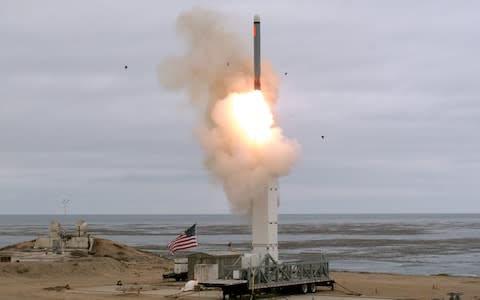Putin promises 'symmetrical response' to US missile test after end of nuclear treaty

Vladimir Putin has promised a “symmetrical response” to the US test of a missile banned under a nuclear weapons treaty rubbished this month by the Trump administration amid fears of a new arms race.
A new land-based version of the navy's Tomahawk cruise missile fired from an island in California struck a target more than 310 miles away on Sunday, according to the Pentagon. The recently defunct 1987 US-Russian intermediate-range nuclear forces treaty banned land-based missiles with ranges between 310 and 3,410 miles.
On Friday, Mr Putin told his security council that the test just 16 days after the treaty's demise proved that the United States had long been developing weapons in violation of the agreement, while accusing Russia of the same as part of a “propaganda campaign”.
He argued that the use of an Mk41 launcher on Sunday confirmed Russia's longstanding complaints that US missile defence installations in Romania and Poland could be repurposed to fire offensive weapons.
By leaving the agreement, Washington wanted to “untie its hands for the deployment to different regions of the world of missiles that were previously banned,” Mr Putin said.
“American politicians at a high level are saying that the deployment of new systems could start in the Asia Pacific region, but that also touches on our vital interests, since this is all close to Russia's borders,” he said.
He ordered the defence and foreign ministries to “analyse the level of the threat to our country created by the aforementioned actions of the United States and take exhaustive steps to prepare a symmetrical response”.

While he did not say exactly what that would be be, it was reported in February that Russia could begin producing a land-based version of its Kalibr cruise missile with a range of 1,600 miles by the end of the year.
“For a symmetrical response, it would be enough to take Kalibr and put it on land and conduct a launch,” defence analyst Alexander Golts told The Telegraph. “That wouldn't take a huge effort.”
Donald Trump's announcement in February that he would withdraw from the INF treaty, which ended the deployment of US ballistic missiles to Europe and of Soviet nukes targeting them, raised fears of a new arms race.
European leaders persuaded Mr Trump to give Russia six months to end its 9M729 missile programme, which the United States had said was in violation of the treaty. Moscow denied this and accused Washington of undermining the agreement with its missile defence plans.
The Pentagon has claimed that the Mk41 launcher used in Sunday's test was not the same as the Aegis Ashore missile defence system in Romania, which is also being deployed to Poland.
In his statement, Mr Putin insisted Russia would not be drawn into an “arms race that is destructive for our economy”. But he also noted that Russia was developing weapons “with no equivalent,” a reference to prospective arms announced last year including a hypersonic glider warhead, underwater nuclear drone and nuclear-powered cruise missile.
The tit-for-tat “response” announced by the president could also include tests of these weapons, according to Mr Golts.
“We can assume that everything Russia has to demonstrate its power will be moved out under the guise of symmetrical measures,” he sad.
While the Kinzhal hypersonic ballistic missile is already in deployment, the United States has claimed that tests of the nuclear-powered cruise missile ended in crashes.
The mysterious engine test explosion that killed at least five and caused a radiation spike in northern Russia this month was believed by some to be related to this programme.

